-
Use Cases
-
Resources
-
Pricing
Roman Republic Timeline
(509 BCE - 27 BCE)Political Developments
Overthrow of the Roman Kingdom
509 BCE
% complete
The Overthrow of the Roman Kingdom refers to the removal of the last king of Rome, Lucius Tarquinius Superbus, in 509 BCE. This event marked the transition from the Roman Kingdom to the Roman Republic, establishing a new form of government based on the principles of democracy and the rule of law.
Image source: Overthrow of the Roman monarchy

Creation of the Roman Republic
509 BCE
% complete
The Roman Republic was established in 509 BCE, following the overthrow of the Roman Kingdom. It marked the transition from a monarchical system to a republican form of government. The creation of the Republic was influenced by the ideals of Greek democracy and aimed to prevent the excessive concentration of power in the hands of a single ruler. The Republic was governed by two consuls who were elected annually and served as the highest authority. It was during the Republic that Rome expanded its territory through conquest and established itself as a dominant power in the Mediterranean region.
The Twelve Tables of Law
450 BCE
% complete
The Twelve Tables of Law were a set of laws created by the Roman Republic in 450 BCE. These laws were engraved on twelve bronze tablets and displayed in the Roman Forum for all citizens to see. The Twelve Tables covered a wide range of legal matters, including property rights, contracts, and criminal offenses. This was an important development in Roman law as it provided a written code of laws that applied to all citizens, regardless of their social status. The Twelve Tables of Law formed the basis of Roman civil law and influenced legal systems around the world.
Image source: Twelve Tables
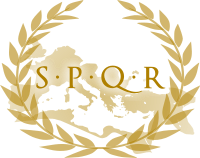
Lex Hortensia
287 BCE
% complete
Lex Hortensia was a law passed by the Roman Republic in 287 BCE. It was named after the plebeian dictator Quintus Hortensius, who proposed the law. The Lex Hortensia gave the resolutions of the Plebeian Council the same legal standing as those of the Roman Senate. This law marked a significant shift in power from the patricians to the plebeians, as it enhanced the authority of the Plebeian Council. It also helped to resolve conflicts between the patricians and plebeians, and solidify the political and legal framework of the Roman Republic.
Sulla's Dictatorship
82 BCE - 79 BCE
% complete
Sulla's Dictatorship was a period of absolute rule by the Roman general Lucius Cornelius Sulla from 82 BCE to 79 BCE. Sulla came to power after a series of civil wars and used his dictatorship to carry out significant political and social reforms. He purged his enemies, redistributed land to his supporters, and increased the power of the Senate. Sulla's dictatorship marked a turning point in Roman history and set a precedent for future leaders to seize power through force.
Image source: Proscription

First Triumvirate
60 BCE - 53 BCE
% complete
The First Triumvirate was a political alliance formed in 60 BCE by three influential Roman politicians: Julius Caesar, Pompey the Great, and Marcus Licinius Crassus. The purpose of the alliance was to consolidate their power and influence in Rome. Together, the three men were able to dominate Roman politics and make significant changes to the government and society. However, the alliance eventually fell apart, leading to the outbreak of civil war and ultimately the end of the Roman Republic.
Image source: First Triumvirate

Assassination of Julius Caesar
44 BCE
% complete
The Assassination of Julius Caesar occurred on March 15, 44 BCE. Julius Caesar, the Roman dictator, was stabbed to death by a group of senators led by Marcus Junius Brutus. The assassination was motivated by a desire to preserve the Roman Republic and prevent Caesar from becoming a tyrant. It marked the end of the Roman Republic and the beginning of the Roman Empire.
Image source: Assassination of Julius Caesar

Second Triumvirate
43 BCE - 33 BCE
% complete
The Second Triumvirate was a political alliance formed in ancient Rome in 43 BCE between Octavian, Mark Antony, and Lepidus. It was created to establish stability in the aftermath of the assassination of Julius Caesar and to consolidate their own power. The alliance lasted for 10 years, with Octavian eventually emerging as the sole ruler of Rome and transforming the Roman Republic into the Roman Empire.
Image source: Second Triumvirate

Octavian becomes Augustus
27 BCE
% complete
Octavian becomes Augustus on January 16, 27 BCE. He was the first emperor of the Roman Empire and ruled until his death on August 19, 14 CE. This event marked the transition from the Roman Republic to the Roman Empire.
Image source: Augustus

Pax Romana
27 BCE - 180 CE
% complete
Pax Romana was a period of relative peace and stability in the Roman Empire that lasted from 27 BCE to 180 CE. It was characterized by a strong central government, efficient administration, and a flourishing economy. This period saw the expansion of Roman territory, the development of infrastructure, and the spread of Roman culture and civilization. It was a time of prosperity and cultural achievement, with notable figures like Augustus, Trajan, and Hadrian leading the empire.
Diocletian's Reforms
284 CE
% complete
Diocletian's Reforms were a series of political, economic, and military reforms implemented by the Roman Emperor Diocletian in 284 CE. These reforms aimed to stabilize the Roman Empire and combat its internal and external challenges. Diocletian implemented changes such as dividing the empire into four separate administrative regions, known as the tetrarchy, with two senior emperors and two junior emperors. He also introduced the system of Dioceses and Provinces to effectively govern the regions. Additionally, Diocletian reformed the economy by stabilizing prices, increasing state control over professions, and regulating trade. The military was reorganized with the creation of the comitatus, a mobile field army, and the limitanei, a border guard. These reforms played a crucial role in strengthening the Roman Empire and prolonging its existence.
Image source: Diocletian

Military Campaigns
Conquest of Veii
396 BCE
% complete
The Conquest of Veii was a military campaign by the Roman Republic against the Etruscan city of Veii, located near present-day Rome. The campaign started in 406 BCE and lasted for 10 years, ending in 396 BCE. The Romans besieged Veii for several years before finally capturing and sacking the city. This victory marked a significant expansion of Roman territory and demonstrated the growing power of the Republic.
Gallic Sack of Rome
390 BCE
% complete
The Gallic Sack of Rome was an attack on the city of Rome by the Senones, a Gallic tribe, in 390 BCE. The Gauls managed to breach the city walls and ransacked Rome, causing widespread destruction and looting. It was a major humiliation for the Romans and a wake-up call for the need to strengthen their defenses.
Image source: Battle of the Allia
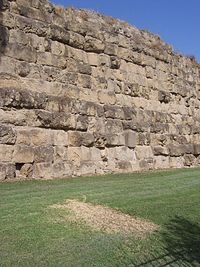
Samnite Wars
343 BCE - 290 BCE
% complete
The Samnite Wars were a series of conflicts between the Roman Republic and the Samnites, an ancient Italic people, from 343 BCE to 290 BCE. These wars were primarily fought over territorial control in the central Apennine Mountains of Italy.
Image source: Samnite Wars
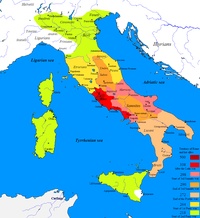
Pyrrhic War
280 BCE - 275 BCE
% complete
The Pyrrhic War was a series of conflicts fought by the Roman Republic against the Kingdom of Epirus, led by King Pyrrhus. The war lasted from 280 BCE to 275 BCE and consisted of several significant battles, including the Battle of Heraclea and the Battle of Asculum. The war is named after Pyrrhus of Epirus, who famously said after winning a costly victory, 'One more such victory and we are undone.' Despite winning some battles, Pyrrhus suffered heavy losses and ultimately withdrew from Italy, leaving the Roman Republic in control of the region.
Image source: Pyrrhic War
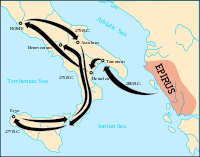
Punic Wars
264 BCE - 146 BCE
% complete
The Punic Wars were a series of three wars fought between Rome and Carthage from 264 BCE to 146 BCE. The wars resulted in the eventual destruction of Carthage and the rise of Rome as the dominant power in the western Mediterranean.
Image source: Punic Wars
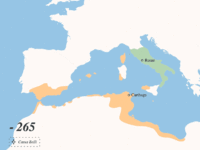
Julius Caesar's Conquest of Gaul
58 BCE - 50 BCE
% complete
Julius Caesar's Conquest of Gaul was a military campaign carried out by Julius Caesar, the Roman general and statesman, from 58 BCE to 50 BCE. During this time, Caesar led the Roman Republic's army in a series of successful battles and campaigns against the Gallic tribes in the area known as Gaul, which is present-day France, Belgium, Switzerland, and parts of Italy and Germany. The conquest of Gaul was a significant achievement for Caesar and played a crucial role in his rise to power and eventual domination of the Roman Republic. The campaign involved numerous battles, sieges, and diplomatic negotiations, and it helped establish Caesar's reputation as a capable military commander. The conquest of Gaul also brought vast wealth and resources to the Roman Republic, further strengthening its position in the Mediterranean region.
Image source: Gallic Wars
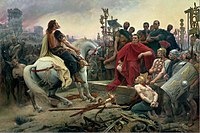
Crossing the Rubicon
49 BCE
% complete
Crossing the Rubicon was a significant event in the history of the Roman Republic that took place in 49 BCE. It marked the point of no return for Julius Caesar as he led his army across the Rubicon River in Italy, defying the orders of the Senate and sparking a civil war. This event ultimately led to Caesar's rise to power and the end of the Roman Republic.
Image source: Crossing the Rubicon

Battle of Actium
31 BCE
% complete
The Battle of Actium was fought between the forces of Mark Antony and Cleopatra on one side, and Octavian (later known as Augustus) on the other. It took place on September 2, 31 BCE, near Actium in Greece. The battle resulted in a decisive victory for Octavian, leading to the end of the Roman Republic and the beginning of the Roman Empire.
Image source: Battle of Actium

Battle of the Milvian Bridge
312 CE
% complete
The Battle of the Milvian Bridge took place on October 28, 312 CE. It was a battle between the Roman emperors Constantine I and Maxentius. Constantine won the battle, leading to his ascent as the sole ruler of the Western Roman Empire. The battle is significant for its impact on the history of Christianity, as Constantine attributed his victory to the Christian God, leading to the Edict of Milan and the eventual establishment of Christianity as the state religion of the Roman Empire.
Image source: Battle of the Milvian Bridge

Social Reforms
Social War
91 BCE - 88 BCE
% complete
The Social War was a conflict in ancient Rome fought between the Roman Republic and several of its Italian allies. It lasted from 91 BCE to 88 BCE. The war began as a result of the Roman Republic's refusal to grant full Roman citizenship rights to its Italian allies.
Roman Citizenship granted to all free inhabitants of the Empire
212 CE
% complete
Roman Citizenship granted to all free inhabitants of the Empire (212 CE)
Decline and Transition
Transition from Republic to Empire
27 BCE
% complete
The Transition from Republic to Empire marks the end of the Roman Republic and the beginning of the Roman Empire. It occurred in 27 BCE when Gaius Octavius, also known as Octavian or Augustus, became the first Roman emperor. Octavian, the adopted son of Julius Caesar, consolidated his power and established a new political system that centered on a single ruler with ultimate authority. This transition brought an end to the republican institutions and the beginning of imperial rule, leading to significant changes in Roman society, politics, and governance.
Image source: Roman Empire

Crisis of the Third Century
235 CE - 284 CE
% complete
The Crisis of the Third Century refers to the period of political, military, and economic instability in the Roman Empire from 235 CE to 284 CE. It was characterized by frequent changes in emperors, civil wars, barbarian invasions, economic decline, and social unrest. During this time, the empire faced numerous challenges, including the secession of various provinces, economic crises, and the constant threat of external invasions. The Crisis of the Third Century marked a significant turning point in the history of the Roman Empire and set the stage for the transformation from the Roman Republic to the Roman Empire.
Image source: Crisis of the Third Century
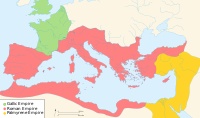
Cultural Achievements
Construction of the Colosseum
72 CE - 80 CE
% complete
The construction of the Colosseum started in 72 CE and was completed in 80 CE. It was a massive amphitheater located in Rome, Italy, and was used for various events such as gladiator fights, animal hunts, and public spectacles. The Colosseum could hold up to 50,000 spectators and had a complex system of tunnels and chambers underneath the main arena. It was a symbol of the power and grandeur of the Roman Empire and remains a popular tourist attraction today.
Image source: Colosseum
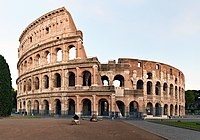
Key Facts
- The Roman Republic was established in 509 BCE after the overthrow of the Etruscan monarchy.
- The Roman Republic was governed by two consuls who were elected annually and had equal powers.
- In 287 BCE, the plebeians gained equal legal status with the patricians, leading to more democratic reforms.
- The Roman Republic expanded its territory through a series of wars known as the Punic Wars.
- The Roman Republic faced several internal and external threats, including the assassination of Julius Caesar in 44 BCE.
Source
This Roman Republic timeline was generated with the help of AI using information found on the internet.
We strive to make these timelines as accurate as possible, but occasionally inaccurates slip in. If you notice anything amiss, let us know at [email protected] and we'll correct it for future visitors.
Create a timeline like this one for free
Preceden lets you create stunning timelines using AI or manually.
Customize your timeline with one of our low-cost paid plans
Export your timeline, add your own events, edit or remove AI-generated events, and much more
Free
$
0
free forever
No credit card required.
Basic
$
10
/month
billed annually
Cancel anytime.
Pro
$
16
/month
billed annually
Cancel anytime.
Common Questions
Can I cancel anytime?
Yes. You can cancel your subscription from your account page at anytime which will ensure you are not charged again. If you cancel you can still access your subscription for the full time period you paid for.
Will you send an annual renewal reminder?
Yes, we will email you a reminder prior to the annual renewal and will also email you a receipt.
Do you offer refunds?
Yes. You can email us within 15 days of any payment and we will issue you a full refund.
What if I have more questions?
Check out our pricing docs or send us an email anytime: [email protected].